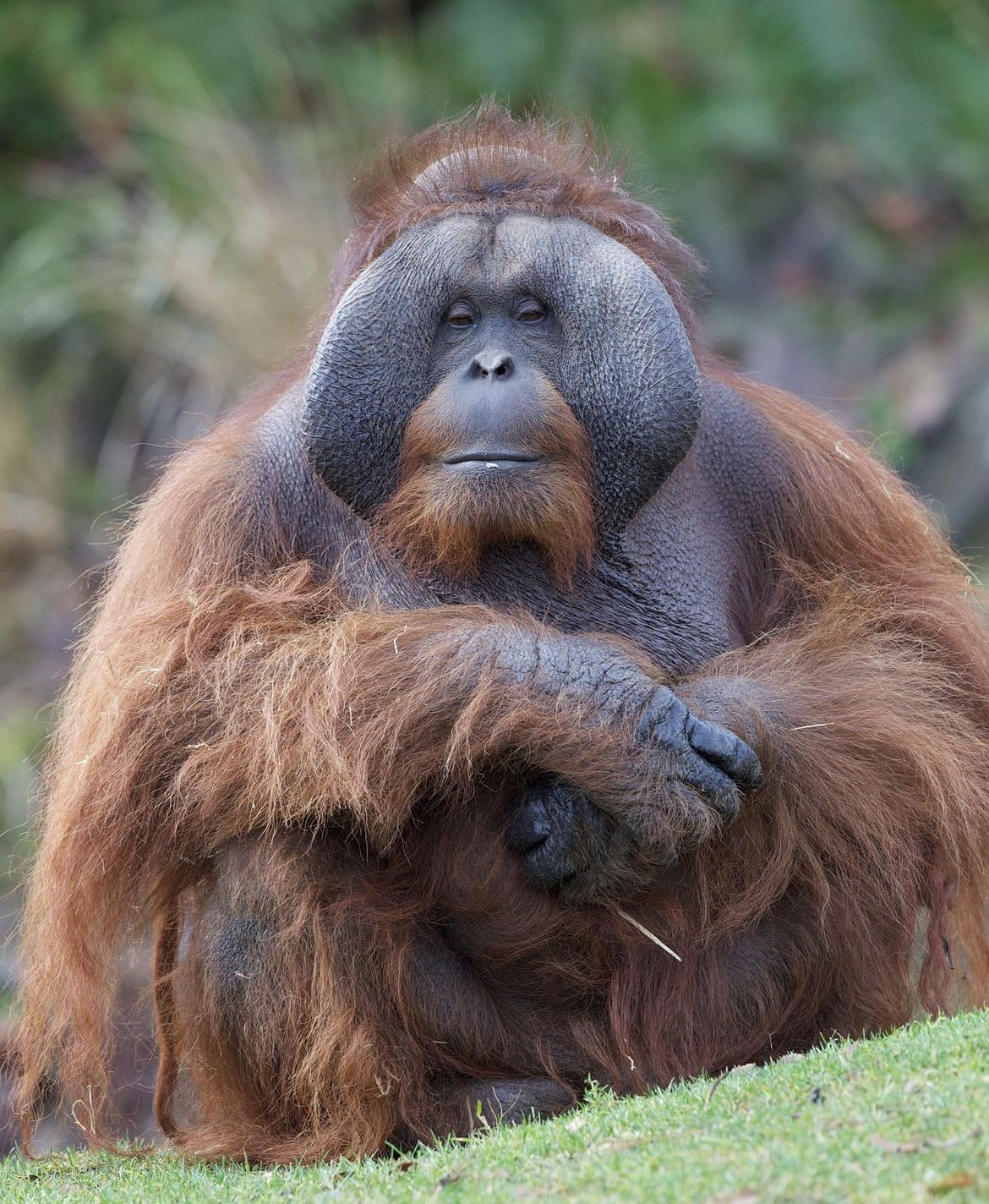Nicknamed, the Guardians of the Forest, the Orangutan is one of the most remarkable and intelligent primates on our planet.
Picture this: deep in the lush, vibrant jungles of Indonesia and Malaysia, there’s a creature with a wise gaze, a gentle demeanor, and an impressive ability to swing from tree to tree with the grace of a seasoned acrobat.
Ready to learn more about our orange-haired cousins?
What is the Orangutan?
Orangutans, whose name literally translates to “person of the forest” in Malay, are the world’s largest tree-dwelling mammals.
They’re the philosophers of the animal kingdom, spending a lot of their time chilling out, munching on fruit, and contemplating the complexities of the forest (or so we like to imagine). But don’t let their laid-back lifestyle fool you; these creatures are critically important to their ecosystem and are incredibly intelligent.
There are two main species to talk about: the Bornean orangutan (Pongo pygmaeus) and the Sumatran orangutan (Pongo abelii). Each has its own unique quirks, habitat preferences, and conservation status.
The Bornean kind is more widespread but both species face significant threats from human activity. And if you’re picturing a third type, the Tapanuli orangutan (Pongo tapanuliensis), you’re ahead of the curve. Discovered not too long ago, these rare creatures remind us of how much there is still to learn about our world.
What Do Orangutans Look Like?
Imagine the coolest, most laid-back dude you know. Now, give him a thick, reddish-brown coat of hair, long arms capable of reaching fruit from the furthest branches, and expressive, thoughtful eyes that seem to peer into your soul. That’s your orangutan.
Males are particularly striking, with large, cheeky flaps that make them look like the elders of the forest. These flaps aren’t just for show; they play a role in attracting mates and making their calls sound more impressive. Females, on the other hand, are more petite but equally as fascinating, with a gentleness and intelligence that shine through in their interactions with their young.
Orangutans have a distinctive body shape, with a robust torso and incredibly long arms – we’re talking arms that can span up to 7 feet from fingertip to fingertip on the big males. This adaptation is perfect for their arboreal lifestyle, enabling them to navigate the forest canopy with ease. Their hands and feet are equally adapted for life in the trees, with hook-like fingers and toes that grip branches securely as they swing through their leafy domain.
How Big Are Orangutans?
When it comes to size, orangutans really know how to bring their A-game. Adult males can be quite the heavyweights, tipping the scales at around 220 pounds (100 kilograms), and standing about 4.5 feet (1.4 meters) tall when upright. Females, on the other hand, are a bit more on the petite side, usually weighing around half as much as the males.
But it’s not just their weight that’s impressive. Remember those long arms we talked about? They’re not just for show. The arm span of a fully grown male can reach up to 7 feet (over 2 meters) from fingertip to fingertip. That’s like being able to dunk a basketball without even jumping – if orangutans were into that sort of thing.
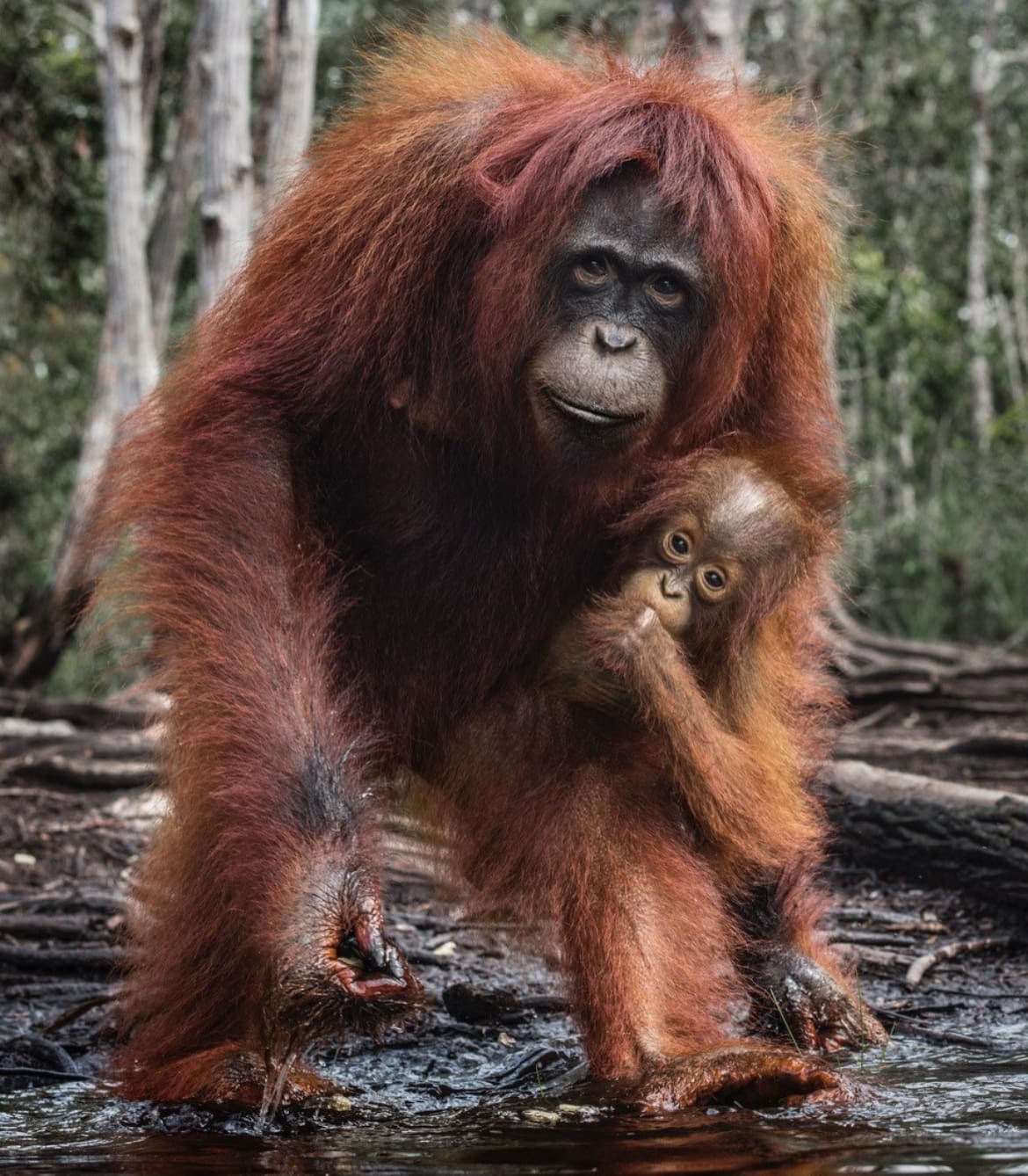
Orangutan Skin
Beneath their thick, reddish-brown hair, orangutans sport quite sensitive skin. Their skin is a muted shade of grey or black, which might not be visible unless you’re up close and personal (not recommended without expert supervision, by the way).
This skin plays a crucial role, not just in protecting their body but also in regulating their temperature, especially in the humid, tropical climate they call home.
Orangutan Teeth
Let’s talk about those pearly whites (or not so pearly, depending on their diet and age).
Orangutans have a set of 32 teeth, much like us humans. But their dental layout is designed to chow down on a variety of forest fare, from fruits to leaves, and even the occasional insect or two.
The most striking feature? Their canines. These teeth can be pretty intimidating, especially in males, and they’re used for more than just eating – they’re a key part of displays of dominance and mate attraction.
Arms & Hands
Orangutans could easily win any tree-climbing contest. Their arms are not only long but also incredibly strong, allowing them to swing from branch to branch with the grace of a gymnast. These long arms are complemented by their unique hands, which are almost as versatile as ours.
Their fingers are long and curved, perfect for grasping branches and picking fruit. But it’s their thumbs that are really interesting – they’re opposable, just like ours, giving them the ability to handle objects with precision.
Their feet are equally adapted for their arboreal lifestyle, with toes that function almost like a second set of hands. This dexterity allows them to navigate the complex architecture of the forest canopy, making them masters of their environment.

Orangutan Colouration
The orangutan’s coat is a masterpiece of nature, a vivid tapestry that blends perfectly with the sun-dappled environment of the rainforest. Ranging from a deep, rusty red to a softer, more muted auburn, their fur not only provides them with camouflage but also a bit of flair.
The coloration varies between the two species, with Sumatran orangutans typically sporting a lighter shade compared to their Bornean counterparts.
This colouration isn’t just for show; it plays a crucial role in regulating their temperature and protecting their skin from the harsh tropical sun.
What Do Orangutans Eat?
If you ever find yourself dining with an orangutan, be prepared for a fruit-heavy feast. These guys are frugivores at heart, with a sweet tooth for figs, lychees, and durians, making up a significant portion of their diet. But it’s not all sweet treats; they also munch on leaves, bark, and occasionally insects or small vertebrates for a protein kick.
Orangutans are known to be picky eaters, selecting only the ripest and most nutritious fruits. This discerning taste has a larger purpose, as it helps in seed dispersal, promoting forest regeneration. So, in a way, orangutans are the unsung gardeners of the rainforest, ensuring the health and diversity of their habitat.

Orangutan Social Structure
Think of orangutans as the introverts of the primate world. They value their alone time, with adult males and females usually living solitary lives, except for mothers with their young. This isn’t to say they’re antisocial; their paths often cross, leading to interactions that range from friendly to competitive, especially among males.
The bond between a mother and her offspring is the cornerstone of orangutan society. Mothers are incredibly nurturing, caring for their young for up to eight years, teaching them the essential skills for survival in the canopy. This prolonged childhood—one of the longest in the animal kingdom—is crucial for learning the complex navigation and foraging skills needed in their vast forest home.
Male orangutans, on the other hand, lead a more solitary existence, with their social interactions often revolving around access to fertile females or disputes over territory. It’s in these moments that the depth of their social intelligence is revealed, navigating the delicate balance between competition and coexistence.
How Do Orangutans Reproduce?
Orangutan romance is a slow dance, marked by patience and rare encounters. Females reach sexual maturity around the age of 12, while males can be late bloomers, not fully maturing until their late teens. Unlike many other animals, orangutans don’t have a specific breeding season; they mate year-round.
The courtship, if you can call it that, is relatively straightforward, often initiated by females who signal their readiness to receptive males. What follows is a brief but meaningful encounter, leading to a gestation period of about 8.5 months. Mothers then embark on the journey of raising their offspring alone, dedicating years to their young’s education in the ways of the forest.
A mother orangutan’s dedication is unparalleled. She will care for her offspring for up to eight years, teaching them vital survival skills such as foraging, nest building, and tree climbing. This extended childhood is crucial for orangutans, given the complexity of their arboreal habitat and the depth of knowledge required to navigate it.
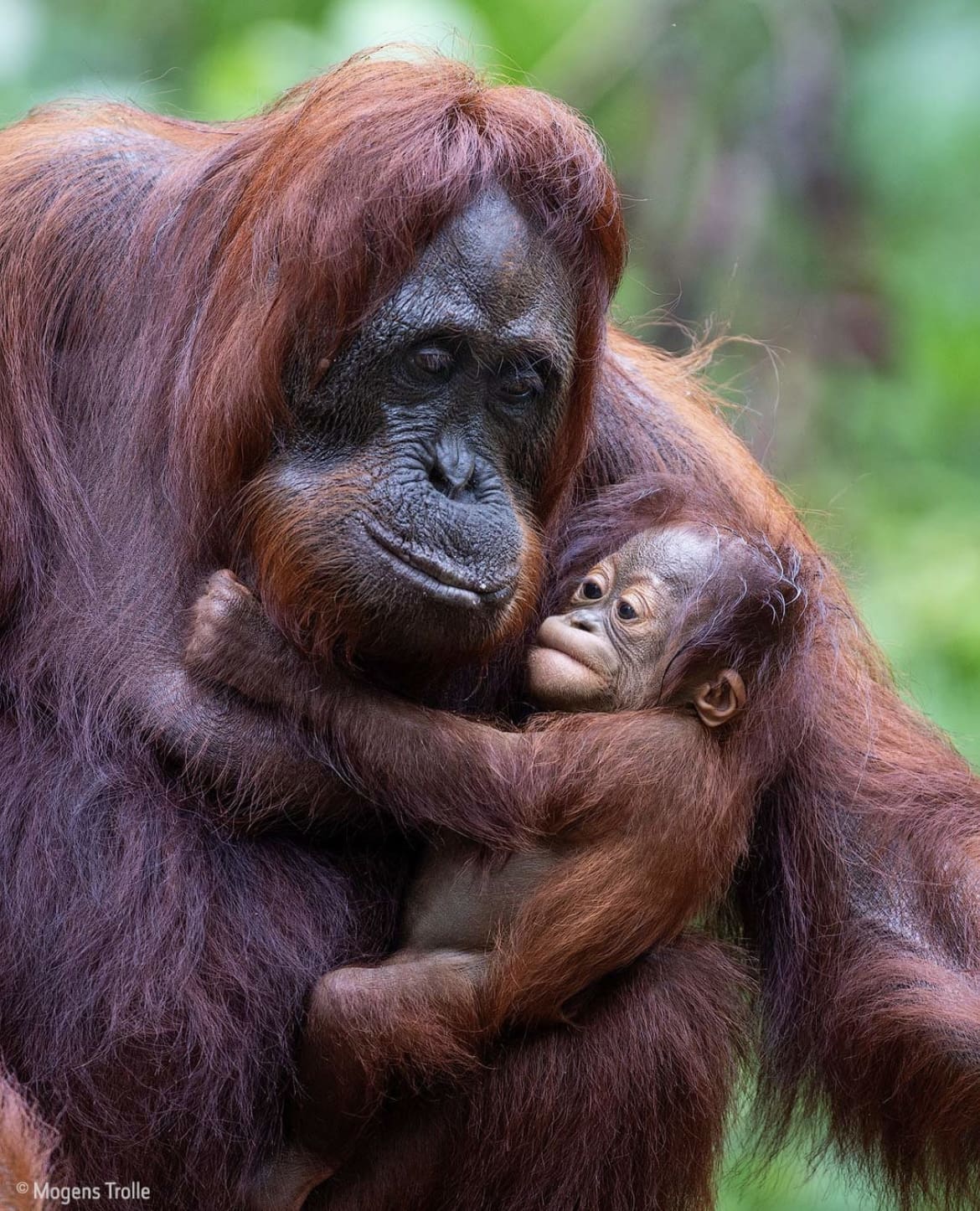
How Long Do Orangutans Live?
Orangutans boast impressive lifespans, particularly when shielded from the threats of predation and human impact. In the wild, they can live up to 40 years, though instances of orangutans reaching their 50s have been documented in captivity. This longevity is a testament to their robust nature and the complexity of the social and environmental knowledge they accumulate over the years.
Their long life contributes to the species’ slow reproductive rate, with females giving birth to a new offspring only every 7 to 8 years. This slow pace of population growth highlights the critical impact of habitat loss and hunting on their numbers, as recovering from population declines is a slow process for orangutans.
Is Orangutan Dangerous?
Despite their imposing size and strength, orangutans are generally not dangerous to humans. They are shy, reserved animals that prefer to avoid conflict. However, like any wild animal, they can become aggressive if they feel threatened, particularly if their space is invaded or if they’re competing for resources.
The perception of orangutans as dangerous likely stems from their sheer strength and the display behaviors of dominant males. However, these behaviors are mostly reserved for inter-species competition and rarely directed towards humans. It’s crucial to respect their space and remember that any aggressive behavior is primarily driven by fear or the need to protect themselves or their offspring.
Are Orangutans Territorial?
Orangutans are indeed territorial, but their approach to territory differs significantly from what we might expect. Adult males are the most territorial, establishing and defending areas that provide ample access to food and potential mates. These territories can overlap with those of females and less dominant males, leading to a complex mosaic of orangutan domains within the forest.
The concept of territory among orangutans is more fluid than rigid. Males announce their presence through loud, long calls that resonate through the forest, serving both to attract females and to deter rival males.
These vocal displays help maintain order and distance between individuals, reducing the need for physical confrontation. However, when encounters do occur, they can lead to tense standoffs or even physical altercations, although such instances are relatively rare.
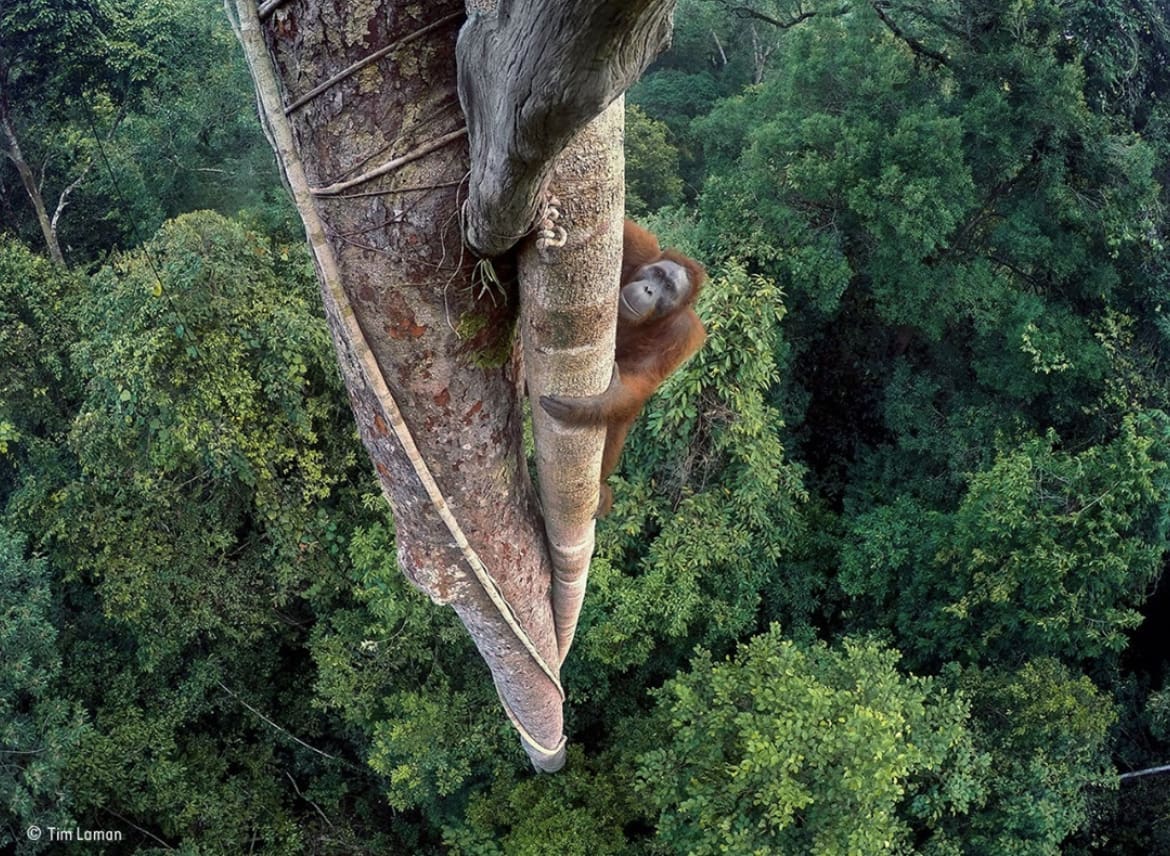
How Fast Are Orangutans?
When it comes to speed, orangutans won’t be winning any sprints. Their movement through the trees is deliberate and measured, more about precision and grace than sheer speed.
In their arboreal highway, they can travel at speeds of up to 1 km/h (0.6 mph) when swinging or “brachiating” from branch to branch. On the ground, they’re capable of moving a bit faster, but they prefer to keep to the trees, where they are most adept and secure from predators.
This deliberate pace is a reflection of their lifestyle, focused on foraging for food and maintaining a low profile to avoid threats. Their strength lies in their ability to navigate the complex three-dimensional environment of the rainforest canopy, using their intelligence and dexterity to move efficiently and effectively.
Where Do Orangutans Live?
Orangutans are the epitome of tree-huggers, spending most of their lives in the dense, biodiverse rainforests of Borneo and Sumatra. These forests provide everything they need, from the high canopies they sleep in to the bounty of fruit that forms the bulk of their diet.
The habitat of orangutans is as varied as it is vibrant, ranging from lowland rainforests to mountainous regions, peat swamps, and mangroves. Each environment offers a unique set of resources and challenges, shaping the behaviors and adaptations of orangutan populations. For instance, orangutans in Sumatra are known to use tools more frequently, a behavior that’s less commonly observed in their Bornean counterparts.
These rainforests are not just a home for orangutans; they’re a crucial part of the ecological balance, playing a vital role in carbon storage, climate regulation, and supporting a myriad of other species. The survival of orangutans is intrinsically linked to the health of these forests, highlighting the importance of conservation efforts to protect these irreplaceable ecosystems.

How Many Orangutans Are There in the Wild?
Orangutan populations have faced significant declines over the past few decades, primarily due to human activities. The Bornean orangutan is classified as Critically Endangered, with an estimated population of around 104,700 individuals.
The Sumatran orangutan is also Critically Endangered, with about 13,846 individuals remaining. The newly identified Tapanuli orangutan, residing in a limited area in Sumatra, is the most endangered of all, with fewer than 800 individuals.
These numbers, while stark, underscore the urgent need for conservation efforts. The slow reproductive rates of orangutans, combined with their dependence on large territories of forest, mean that their populations are particularly vulnerable to habitat destruction and fragmentation.
Are Orangutans Endangered?
Absolutely, orangutans are endangered, with each species facing a high risk of extinction in the wild. Their status as Critically Endangered highlights the severe impact of human activity on their populations and habitats. The primary threats to orangutans include deforestation for palm oil plantations, logging, mining, and human encroachment, all of which fragment their living spaces and reduce their access to food.
Illegal hunting and the pet trade also pose significant risks, with infants being particularly vulnerable when their mothers are killed. Climate change further exacerbates these threats, altering the orangutans’ habitats and affecting the availability of food resources.
Threats to Orangutans in the Wild
Orangutans face a myriad of threats in the wild, many of which are exacerbated by human activities. Deforestation is at the forefront, driven by the expansion of palm oil plantations, logging, and agricultural development. This not only destroys their habitat but also fragments it, isolating populations and making it difficult for them to find mates and access food.
Illegal hunting, whether for meat, traditional medicine, or the pet trade, further diminishes their numbers. Orangutans are slow to reproduce, and the loss of even a few individuals can have significant impacts on local populations. Additionally, human-orangutan conflict arises when these great apes venture into plantations or farms in search of food, leading to lethal retaliation by humans.
The effects of climate change, such as changes in fruiting seasons and extreme weather events, also pose indirect threats to orangutan survival by altering their habitat and food availability.
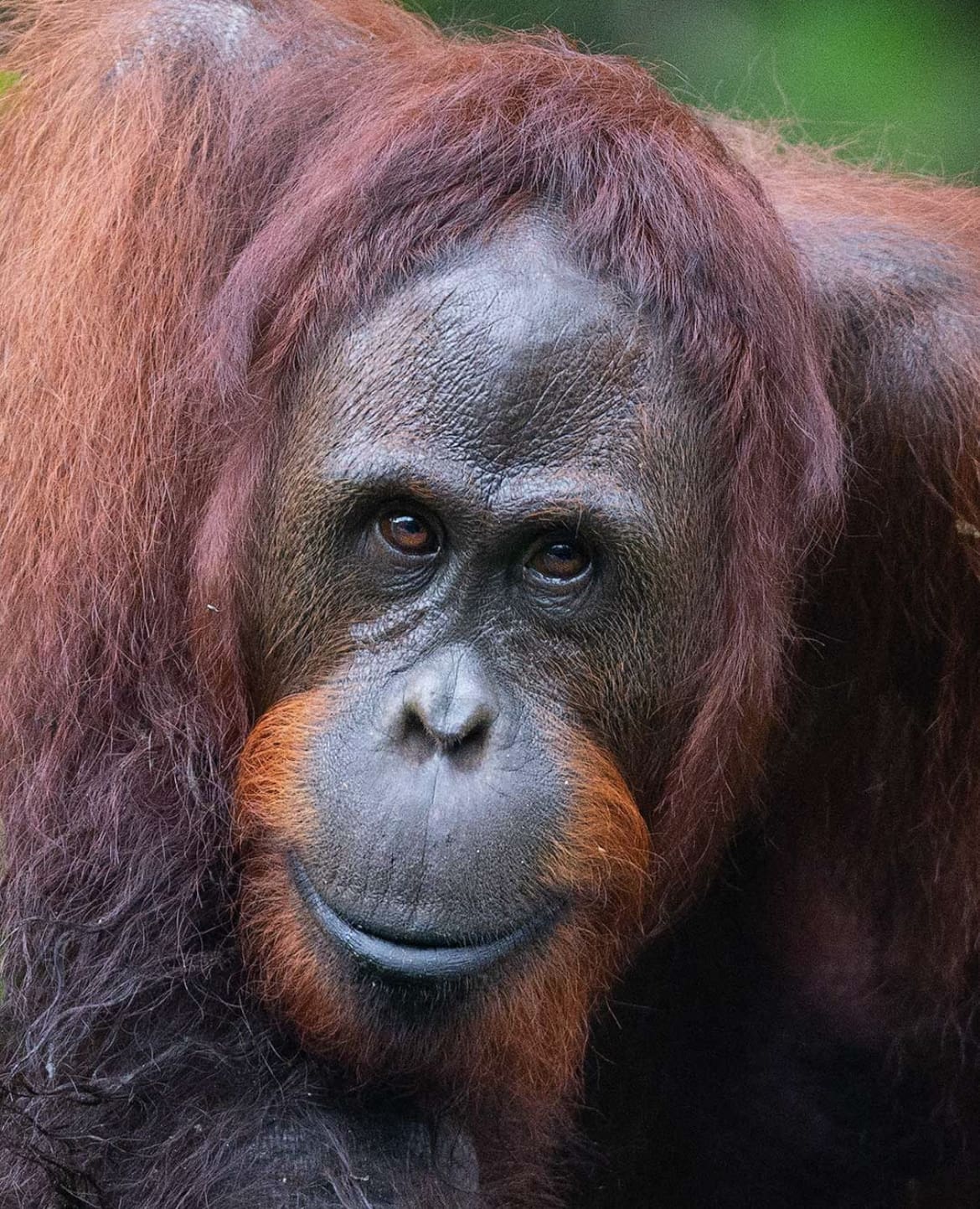
Where to See Orangutans in the Wild
For those yearning to witness orangutans in the wild, Borneo and Sumatra are your go-to destinations. These islands are the only places in the world where orangutans can be found in their natural habitat. Several national parks and wildlife reserves offer opportunities for ethically responsible orangutan sightings.
In Borneo, the Tanjung Puting National Park in Central Kalimantan is renowned for its orangutan conservation efforts and offers guided tours where visitors can observe these apes in the wild. The Kinabatangan Wildlife Sanctuary in Sabah is another hotspot, known for its rich biodiversity, including a significant orangutan population.
Sumatra’s Gunung Leuser National Park is a haven for wildlife enthusiasts, offering the chance to spot not just orangutans but also other rare species like the Sumatran tiger and rhinoceros.
When planning a visit, opt for eco-friendly tours and accommodations that support local conservation efforts. Remember, the goal is to observe these magnificent creatures without disrupting their natural behaviors or habitat.
Tips for Spotting Orangutans
Spotting orangutans in the dense rainforest can be challenging, but a few tips can increase your chances of a memorable encounter:
- Go with a knowledgeable guide: Local guides know the forest and the orangutans’ habits, increasing your likelihood of sightings.
- Visit during fruiting season: Orangutans are more active and easier to spot when their favorite fruits are abundant.
- Early mornings and late afternoons: These are the times when orangutans are most active, foraging for food or building nests.
- Keep quiet and move slowly: Noise and rapid movements can startle orangutans and other wildlife, reducing your chances of sightings.
- Respect their space: Maintain a safe distance to avoid stressing the animals. Remember, we’re visitors in their home.
Facts about The Orangutan
- Highly Intelligent: Orangutans are known for their remarkable problem-solving skills and use of tools in the wild.
- Long Childhood: Orangutans have one of the longest childhood dependencies in the animal kingdom, with young relying on their mothers for up to eight years.
- Significant Contributors to Forest Regeneration: Through their diet, orangutans play a crucial role in seed dispersal, aiding in the growth of new forest areas.
- Unique Individuals: Just like humans, orangutans have distinct personalities, with some being more curious, bold, or shy than others.
- Communicative Creatures: Orangutans use a variety of sounds to communicate with one another, from grunts and calls to the distinctive “long call” of the male orangutan.
Myths about The Orangutan
- Orangutans are aggressive: In reality, orangutans are generally peaceful and solitary. Aggression is rare and usually a response to a perceived threat.
- They can be kept as pets: Orangutans are wild animals, not pets. Keeping them in captivity often leads to psychological stress and physical harm.
- All orangutans are the same: There are three distinct species of orangutans (Bornean, Sumatran, Tapanuli), each with unique characteristics and habitats.
- Orangutans live in trees because they can’t walk: While they are primarily arboreal, orangutans can walk on the ground but prefer the safety and resources available in the trees.
As we conclude our comprehensive dive into the world of orangutans, it’s clear that these creatures are not just fascinating subjects of study but also vital components of their ecosystems.
The survival of orangutans is intrinsically linked to the health of the rainforests they inhabit. By understanding more about their lives, threats, and the efforts to conserve them, we can all play a part in ensuring that future generations may also have the chance to be inspired by these incredible “people of the forest.”

